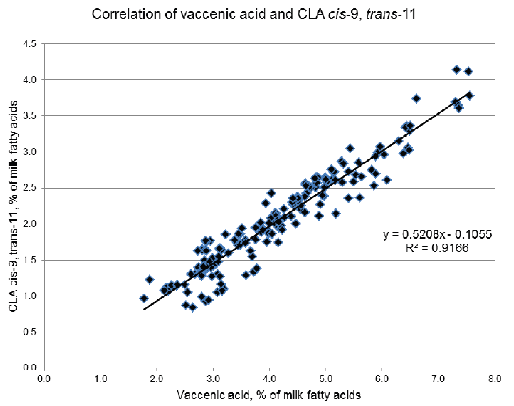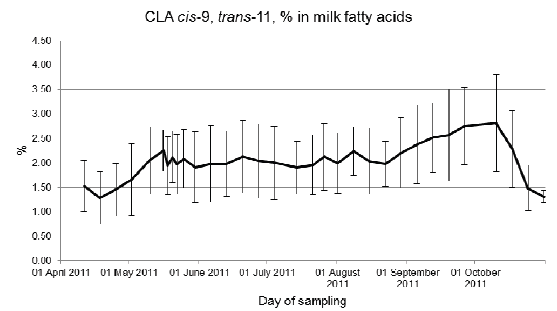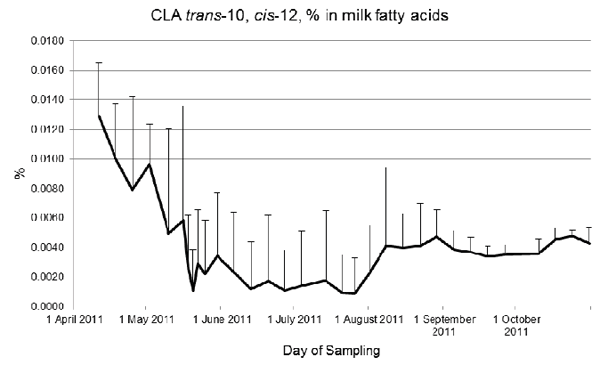Introduction
Including pasture into the diet, results in higher amounts of ruminal bio hydrogenation intermediates like conjugated linoleic acid isomers (CLA) (Kelly et al 1998; Villeneuve et al 2013). They can be detected in milk. By feeding TMR from hay, silage and concentrate, the total CLA concentration in milk drops significantly below milk from pasture. The most researched CLA isomers are the cis-9, trans-11 (rumenic acid=RA) and the trans- 10, cis-12. It has been established, that most of the cis-9, trans-11 isomer in milk is being produced in the mammary gland from vaccenic acid (=VA; C18:1 trans-11) via delta-9 desaturase (Griinari et al 2000). The cis- 9, trans-11 isomer has received high awareness in human nutrition due to its anti-cancer activity (Ha et al 1987). This has been shown in tissue and animal models. It has also been shown in an epidemiological investigation that this isomer holds anti-artherogenic properties in humans (Smit et al 2010). A specific effect in dairy cows has not been established yet. In turn, the trans-10, cis-12 isomer was found to be bioactive in humans as well as in the dairy cow and small ruminants (Shingfield et al 2010). In general, trans-10, cis-12 affects the fat metabolism. Thus it is used by humans via dietary supplements and in food as a body fat management tool. In dairy cows it shows a highly significant, mathematically predictable milk fat reduction (MFR) which was first described by Baumgard et al (2000) and further quantified by Veth et al (2004). The lower milk fat concentration results in lower nutrient requirement per liter of milk. The spared nutrients can be used by the cow to produce more milk and/or as supply to other tissues (Soosten et al 2012, Hötger et al 2013). Ultimately, as shown in a multi-study meta-analysis (Veth et al 2009), the supplementation of CLA to transition cow diets can lead to a reduction in days open and higher pregnancy rates.
It has been shown earlier (Wyss et al 2010), that the RA-profile over 2 consecutive years peaked in late summer/autumn for cows on pasture. For the trans-10, cis-12 isomer, however, due to analytical difficulties with the low levels in milk, no sound annual profiles are available. There are numerous results published, which show that cows on pasture produce milk with lower butter fat level than the same cows on a TMR/silage/hay diet will do (Elgersma et al 2004; Couvreur et al 2006; Couvreur et al 2007; Heck et al 2009; Villeneuve et al. 2013). Two of these authors measured trans-10, cis-12 in milk fat and found higher levels in milk from cows on pasture (Elgersma et al 2004; Villeneuve et al 2013). Since this shows that trans-10, cis-12 is produced under grazing conditions and given the positive effect of this isomer on dairy cow performance, it would be important to know to what extend cows on pasture-only regimens are exposed to this isomer. "Exposure" is used to describe the fact that after ruminal production and absorption in the small intestine, this isomer is potentially affecting the metabolism of various tissues, including the mammary gland before it is ultimately transferred into milk. Therefore the objective of this study was to characterize the exposure of cows on short sward pasture to the most important CLA isomers via their milk fat concentration, pictured as a seasonal profile.
Materials and Methods
From the South of Germany (foothills of the German Alps) we selected 7 farms which have their cows on pasture during the whole grazing period (April to October/November) and have seasonal calving implemented. Due to the observational character of the study, only bulk milk was sampled and no individual cow data was available. Herd sizes were 28 to 65 cows per farm. 5 farms had Simmental, 1 farm had German Frisian and 1 farm had German Brown as breeds. With the exception of two farms, no supplementary feed was offered during the grazing period. One farm provided 1.5 kg of hay per cow each day to attract the cows to the milking parlor. One farm provided 1.5 kg ground barley per cow each day. The cows grazed on a short sward system in which L. perenne, P. pretensis and T. repens were the dominant species. Bulk tank milk samples were taken (ca. 500 g each) weekly to bi-weekly, frozen and collected monthly for shipments to the laboratory Bioanalytik Weihenstephan, Technische Universität München (TUM) where they were analysed by a GC standard process (Firl et al 2014). The fat of the milk sample was extracted and the extract was dissolved in tertiary- butylmethylester to achieve a fat-concentration between 10 and 40 mg/ml solvent. This solution was agitated in a Vortex for 1 minute until the fat was fully dissolved. 100 µl of this solution was transferred by a micro-pipette into a micro-vial, to which 50 µl trimethylsulfonium hydroxide (TMSH) was added before the vial was closed. The micro-vial was shaken and put into the automatic sampler of the GC. The following equipment was used: GC Hewlett Packard 6890 with autosampler 7683 (Agilent); Varian CP 7420 select fame, 100 m, I.D. 0.25 mm, Film 0.25 �m as column, hydrogen 5.0 as carrier and nitrogen 5.0 as make-up gas. The injected volume was 1µl. The split/splitless injector was used with split 50, and samples were injected at 60°C. Then, the oven temperature was raised by 8°C/min to 120°C and by 1.5°C/min to 242°C. Finally, the temperature was raised by 1°C/min to 250°C as the final temperature. Total run time was 101 min, and injector and FID detector temperatures were 260°C and 270°C, respectively. Each peak was identified against a fatty acid standard (Sigma Aldrich, Restek, Biotrend (CLAs)). Because of the low levels of CLA trans-10, cis-12, the method was validated by spiking milk with graded volumes of this isomer, increasing by 0.001% to 0.01 % in milk fat. The limit of quantitation was 0,02 % (relative weight) and the limit of identification was 0,001% (relative weight). trans-10, cis-12 eluded after 68 minutes and heneicosanoic acid after 71 minutes.
A general linear model with the independent variables farm, time and farm x time interaction was applied in the evaluation (SAS).
Results
In the course of the pasture season, the content of CLA cis-9, trans-11 (Figure 1) increased from spring to a summer plateau and peaked in early October at ca. 80% higher levels than in spring. It then declined to spring levels. The variation between the farms was substantial (17 to 40%) The seasonal per farm average of the cis-9, trans-11 isomer ranged from 1.42 to 2.92 % in milk fat. The lowest single sample was found in mid-April with 0.83 % and the highest in September with 4.14 %. The effect of farm, time and the farm x time interaction was statistically highly significant (P < 0.0001)
Figure 1. Seasonal profile of the CLA-isomer cis-9, trans-11 as % of milk fatty acids from weekly bulk tank samples of 7 pasture farms from the South of Germany (weekly means with SD)
The isomer CLA trans-10, cis-12 is present in milk from cows on pasture. However the levels are low and the variation is high (Figure 2). The profile indicates higher levels in early spring, low levels in summer and slightly increasing levels towards the end of the season. Autumn was the season with the least variation; in summer levels were often below detection limit. For the trans-10, cis-12 isomer, annual averages ranged between 0.002 and 0.007 % between farms with a lowest level of 0.000 and a highest (a single mid-May sample) of 0.016 %. Statistically, the 7 farms as well as time and the interaction term had a highly significant effect on the trans-10, cis-12 milk fat concentrations (P < 0.0001).
Figure 2. Seasonal profile of the CLA-isomer trans-10, cis-12 as % of milk fatty acids from weekly bulk tank samples of 7 pasture farms from the South of Germany (weekly means with SD).
Discussion
The results from five farms with an increasing CLA cis-9. trans-11 concentration in milk fat from spring to late summer, are in agreement with literature (Elgersma et al 2006; Butler et al 2009; Wyss et al 2010). The increase starts from June onwards. The other two farms had slightly higher levels in spring, followed by a decrease over summer but also a peak in September. In our study, under the short swart grazing conditions, the cis-9, trans-11 did not correlate over time with C18:3 (linolenic) or C18:2 (linoleic) fatty acids (data not shown) in milk as described previously (Me�uchová et al 2008; Wyss et al 2010). Both fatty acids are known as precursors for CLAs (Bauman et al 2001). VA has been identified (Griinari et al 2000) as the major precursor for the mammary synthesis of cis-9, trans-11, which would explain higher cis-9, trans-11 in milk from grass fed cows. The correlation between VA and the cis-9, trans-11 isomer (Figure 3) was best described in a multiple linear regression model with VA, farm and month as independent variables (r2=0.9166; P < 0.0001). This close correlation has already been described by others (Loor et al 2003; Elgersma et al 2004).
Figure 3. Correlation between the milk fat concentration of vaccenic acid (C 18:1 trans-11) and CLA cis-9, trans-11 (Y=0.521x ? 0.1055; r2=0.9166) from n=186 bulk tank samples across the pasture season �

Considering that trans-10, cis-12 concentrations as low as 0.02% in milk fat come along with a significant MFR (Veth et al 2004; Pappritz et al 2011; Hötger et al 2013), the finding of up to 0.016% in milk from grazing cows is suggesting milk fat reducing effect of spring pasture. Since our main focus was to detect this isomer in milk from grazing cows, we did not collect the very details of farm management. Thus we are not able to correlate the variation in the concentration of trans-10, cis-12 with relevant parameters. The farm with 1.5 kg barley per cow and day had continuous higher levels for much of the season, only decreasing in autumn. Whether this small amount of barley caused this effect could be hypothesized since earlier trials (Bargo et al 2002; Bargo et al 2003) showed that concentrate supplementation of pasture leads to a reduction in milk fat concentration.. Eliminating that farm with barley supplementation from the statistics increased the effect of farm (P < 0.16) and made the interaction insignificant (P < 0.31).
It appears that cows grazing short sward pasture produce trans-10, cis-12 in the rumen which is transferred into milk. Thus it can be considered a natural constituent of pasture milk albeit at low levels. Because of the positive effects of supplementary trans-10, cis-12 on dairy cows, one might speculate, that the higher appearance of this isomer during the natural calving season is at least an interesting coincidence that might warrant further research into a possible pasture-animal interactions.
References
Bargo F., Muller L.D., Kolver E.S., Delahoy J.E. (2003). J. Dairy Sci. 86, 1..
Bargo F., Muller L.D., Delahoy J.E., Cassidy T.W. (2002). J. Dairy Sci. 85, 1777..
Bauman D.E., Corl B.A., Peterson D.G. (2001) The biology of conjugated linoleic acids in ruminants. In ´Advances in Conjugated Linoleic Acid´. (Ed. Sébédio, Christie, Adlof) pp. 146?173. (AOCS Press: Champaign, IL.)
Baumgard L.H., Corl B.A., Dwyer A.D., Saeboe A., Bauman D.E. (2000). Am. J. Physiol. Regulatory Integrative Comp. Physiol. 278, 179.
Butler G., Collomb M., Rehberger B., Sanderson R., Eyre M., Leifert C. (2009) J. Sci. Food Agric. 89, 697.
Couvreur S., Hurtaud C., Lopez C., Delaby L., Peyraud J.L. (2006). J. Dairy Sci. 89, 1956.
Couvreur S., Hurtaud C., Marnet P.G., Faverdin P., Peyraud J.L. (2007) .J. Dairy Sci. 90, 392.
Elgersma A., Ellen G., van der Horst H., Boer H., Dekker P.R., Tamminga S. (2004). Anim. Feed Sci. Technol. 117, 13.
Elgersma A., Tamminga S., Ellen G. (2006).Anim. Feed Sci. Technol. 131, 207.
Firl N., Kienberger H., Rychlik M. (2014). Int. Dairy J. 35, 139.
Griinari J.M., Corl B.A., Lacy S.H., Chouinard P.Y., Nurmela K., Bauman D.E. (2000). J. Nutr. 130, 2285.
Ha Y.L., Grimm N.K., Pariza M.W. (1987). Carcinogenesis 8, 1881.
Heck J., van Valenberg H., Dijkstra J., van Hooijdonk A. (2009). J. Dairy Sci. 92, 4745.
Hötger K., Hammon H.M., Weber C., Görs S., Tröscher A., Bruckmaier R.M., Metges C.C. (2013).J. Dairy Sci. 96, 2258.
Kelly M.L., Kolver E.S., Bauman D.E., van Amburgh M.E., Muller L.D. (1998). J. Dairy Sci. 81, 1630.
Loor J.J., Soriano F.D., Lin X., Herbein J.H., Polan C.E. (2003).Anim. Feed Sci. Technol 109, 105.
Mel'uchová B., Bla?ko J., Kubinec R., Górová R., Dubravská J., Margetín M., Soják L. (2008). Small Ruminant Res. 78, 56.
Pappritz J., Meyer U., Kramer R., Weber E., Jahreis G., Rehage J., Flachowsky G., Dänicke S. (2011) Arch. Anim. Nutr. 65, 89.
Shingfield K, L. Bernard, C. Leroux, Y. Chilliard (2010).animal 4, 1140.
Smit L.A., Baylin A., Campos H. (2010). Am. J. Clin. Nutr. 92, 34.
Soosten D. von, Meyer U., Piechotta M., Flachowsky G., Dänicke S. (2012). J. Dairy Sci. 95, 1222.
Veth M.J. de, Bauman D.E., Koch W., Mann G.E., Pfeiffer A.M., Butler W.R. (2009). J. Dairy Sci. 92, 2662.
Veth M.J. de, Griinari J.M., Pfeiffer A.M., Bauman D.E. (2004). Lipids 39, 365.
Villeneuve M., Lebeuf Y., Gervais R., Tremblay G.F., Vuillemard J.C., Fortin J., Chouinard P.Y. (2013). J. Dairy Sci. 96 , 7181.
Wyss U, A. Münger, M. Collomb (2010) Variation of fatty acid content in grass and milk durig the grazing season. In ´Grassland in a Changing World. Proceedings of the 23rd General Meeting of the European Grassland Federation´. (Ed. Schnyder, Isselstein, Taube, Auerswald, Schellberg, Wachendorf, Herrmann, Gierus, Wrage, Hopkins) pp. 422?424. (Mecke Druck und Verlag: Duderstadt, Germany)








